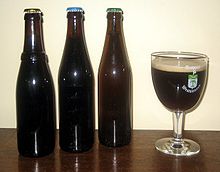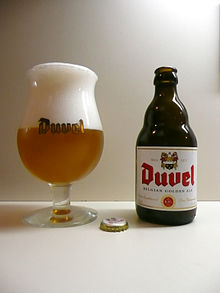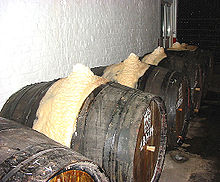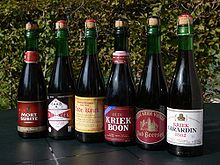- Beer in Belgium
-
Beer in Belgium varies from the popular pale lager to lambic beer and Flemish red. Belgian beer-brewing's origins go back to the Middle Ages. There are approximately 178 breweries in the country,[2] ranging from international giants to microbreweries, which produce a wide range of beers.[3]. In Europe, only Germany, France and the United Kingdom are home to more breweries.[4] Belgians drink 93 litres of beer a year on average.[citation needed]
History
Beer has been made in Belgium since at least the Middle Ages. It is believed today that beer was brewed at some monasteries during this period; however, no written proof exists.[citation needed] The Trappist monasteries that now brew beer in Belgium were occupied in the late 18th century primarily by monks fleeing the French Revolution. However, the first Trappist brewery in Belgium (Westmalle) did not start operation until 10 December 1836, almost 50 years after the Revolution. That beer was exclusively for the monks and is described as "dark and sweet." The first recorded sale of beer (a brown beer) was on 1 June 1861.[5]
Trappist beers
Main article: Trappist beerTrappist beers are beers brewed in a Trappist monastery. For a beer to qualify for Trappist certification, the brewery must be in a monastery, the monks must play a role in its production and policies and the profits from the sale must be used to support the monastery and/or social programs outside. Only seven monasteries currently meet these qualifications, six of which are in Belgium and one in the Netherlands. Trappist beer is a controlled term of origin: it tells where the beers come from, it is not the name of a beer style. Beyond saying they are mostly top-fermented, the beers produced by the Trappist have very little in common stylistically.
The current Belgian Trappist producers are:-
- Achel, sells Blonde (8% ABV), Brune (8% ABV), Extra Blonde (8% ABV), Extra Brune (8% ABV).
- Chimay sells Red Label (dark, 7% ABV), White Label (Blonde/Tripel, ABV 8%) and Blue Label (dark, 9% ABV).
- Orval sells a "unique"[6]dry hopped 6.2% amber beer.
- Rochefort sells three dark beers, "6" (7.5% ABV). "8" (9.2% ABV) and "10" (11.3% ABV).
- Westmalle sells Dubbel (7% ABV) and Tripel (9% ABV),
- Westvleteren sells Green Cap or Blonde, (5.8% ABV), Blue Cap (dark, 8% ABV) and Yellow Cap (dark, 10.2% ABV).
In addition to the above, a lower-strength beer is sometimes brewed for consumption by the Brothers (patersbier) or sold on site.
Abbey beers
Main article: Abbey beerThe designation "abbey beers" (Bières d'Abbaye or Abdijbier) was originally used for any monastic or monastic-style beer. After introduction of an official Trappist beer designation by the International Trappist Association in 1997, it came to mean products similar in style or presentation to monastic beers.[7] In other words, an Abbey beer may be:-
- Produced by a non-Trappist monastery — e.g. Benedictine; or
- produced by a commercial brewery under commercial arrangement with an extant monastery; or
- branded with the name of a defunct or fictitious abbey by a commercial brewer; or
- given a vaguely monastic branding, without mentioning a specific monastery, by a commercial brewer.
In 1999, a "Certified Belgian Abbey Beer" (Erkend Belgisch Abdijbier) logo [8] was introduced by the Union of Belgian Brewers to indicate beers brewed under license to an existing or abandoned abbey.[9], as opposed to other abbey-branded beers which are marketed using other implied religious connections, such as a local saint.[10][11] The requirements for registration under the logo include the monastery having control over certain aspects of the commercial operation, and a proportion of profits going to the Abbey or its designated charities. Monastic orders other than the Trappists can be and are included in this arrangement.
What are now recognized as Trappist breweries began operations began in 1838. Several French monasteries, however, maintained "working" breweries for 500+ years before the French revolution (1789–1799) disrupted religious life across the northern French province of Wallonia. Even then, some Abbey beers such as Affligem Abbey,[11] whose name now appears on beers made by the Heineken-owned Affligem Brewery,[12] resumed brewing from "working" monasteries until Belgium's World War I occupation. Commercial Abbey beers first appeared during Belgium's World War I recovery.
Although Abbey beers do not conform to rigid brewing styles, most tend to include the most recognizable and distinctive Trappist styles of brune (Belgian brown ale, aka dubbel), strong pale ale or tripel, and blonde ale or blond.[7][11] Modern abbey breweries range from microbreweries to international giants.As of 2011, the eighteen certified Abbey beers[13] are :-
- Abbaye de Cambron is brewed in Opzullik (Silly) by Brasserie de Silly.[14]
- Abbaye de Bonne Espérance is brewed in Quenast by Brouwerij Lefebvre.[15]
- Abdij Dendermonde is brewed in Merchtem by Brouwerij De Block.[16]
- Abbaye de Saint-Martin, historically referenced to 1096, is brewed near Tournai by Brasserie_Brunehaut.
- Affligem, produced for Affligem Abbey by a Heineken-owned brewery.
- Brasserie de l'Abbaye du Val-Dieu is located on the grounds of a former abbey.
- Bornem is brewed in Oost-Vlaamse by Brouwerij Van Steenberge.[17]
- Ename is brewed in Oost-Vlaamse by Brouwerij Roman.[18]
- Floreffe is brewed to fund a school housed in a former monastery.
- Grimbergen, made by the large Alken Maes brewery for an extant Norbertine abbey.
- Keizersberg is brewed in Oost-Vlaamse by Brouwerij Van Steenberge.[19]
- Leffe, the Abbey brand of Stella Artois, itself part of the multinational Inbev corporation, is brewed under licence from an extant brewery. It is thought to be the first such arrangement. Leffe has global distribution.
- Maredsous, the Abbey brand of Duvel Moortgat, Belgium's second largest brewer, licensed from Maredsous Abbey.
- Postel is brewed in Opwijk by Brouwerij De Smedt.[20]
- Ramée is brewed in Purnode by Brasserie Du Bocq.[21]
- St. Feuillien is a small independent brewery.
- Steenbrugge is brewed in Brugge by Brouwerij De Gouden Boom.[22]
- Tongerlo is brewed in Boortmeerbeek by Brouwerij Haacht.[23]
Other non-certified Abbey beers include:-
- Abbaye des Rocs is made by a farmers' co-operative and named after a local ruined abbey.[24]
- Kasteelbier, monastic style beers brewed in a castle.
- The St. Bernardus brewery, based on Watou originally brewed under contract for the abbey of St Sixtus at Westvleteren, but now continued on an independent basis, in parallel with production at the monastery itself. Their range is considered a close match in recipe and style to the St Sixtus beers, which can be hard to obtain outside the area.
- Tripel Karmeliet, wirh a three-grain recipe, is produced by Bosteels, an independent brewery who also make Pauwel Kwak.
NOTE: At least one beer writer warns against assuming that closeness of connection with a real monastery confirms a product's quality.[25]
Belgian beer types
Amber ales (Ambrée and Speciale)
These are beers similar to the traditional pale ales of England, although somewhat less bitterly hopped.[26] A notable example is the 5% abv De Koninck brand, with its distinctive spherical glasses (called 'bollekes'). It is popular in its native city of Antwerp. Another is Palm Speciale. Some, such as Vieux Temps, were based on British styles to please troops stationed in Belgium during World War I.[27] Others were introduced by the UK-born brewer George Maw Johnson in the late 19th century.[26] A very strong ambrée is brewed by "Bush" (Dubuisson), another brewery influenced by British styles.
Wallonian amber or ambrée ale, such a La Gauloise Ambrée, is considered to be somewhat distinct by some beer writers, and to be influenced by the French version of the ambrée style.[28]
Blonde or golden ale
These are a light variation on pale ale, often made with pilsner malt.[25] Some beer writers regard blonde and golden ales as distinct styles, while others do not. Duvel is the archetypal Belgian blonde ale, and one of the most popular bottled beers in the country[29] as well as being well-known internationally.[30] Its name means "Devil" and some other blonde beers follow the theme—Satan, Lucifer and Judas for example. The style is popular with Wallonian brewers, the slightly hazy Moinette being the best-known example. Chouffe can be considered a spiced version (with coriander).
Brown ale
Regular bruin or brune beers such as Grottenbier are darker than amber ales, less sour than Flemish brown ale, and less strong than dubbel.
Champagne beers
Champagne style beers are generally ales that are finished "à la méthode originale" for champagne. Examples include Grottenbier, DeuS and Malheur Bière Brut.
Dubbel
Main article: DubbelDubbel (double) has a characteristic brown colour. It is one of the classic Abbey/Trappist types, having been developed in the 19th century at the Trappist monastery in Westmalle. Today, some commercial brewers using abbey names call their strong brown beers "Dubbel". Typically, a dubbel is between 6 and 8% abv. In addition to the dubbels made by most Trappist breweries, examples include Sint Bernardus Pater, Maredsous 8 and Witkap Dubbel.
Dubbels are characteristically bottle conditioned.
Flemish Red
Main article: Flanders red aleTypified by Rodenbach, the eponymous brand that started this type over a century ago, this beer's distinguishing features from a technical viewpoint are a specially roasted malt, fermentation by a mixture of several 'ordinary' top-fermenting yeasts and a lactobacillus culture (the same type of bacteria yoghurt is made with) and maturation in oak. The result is a mildly strong 'drinking' beer with a deep reddish-brown colour and a distinctly acidic, sour yet fruity and mouthy taste. This style is closely related to Oud bruin.
Hop-accentuated beers
A few Belgian beers are pale and assertively hopped, like an India Pale Ale. De Ranke's XX Bitter has a British-style name. Poperings Hommelbier, another example, hails from Belgium's hop-growing district.
Lambic beers (including Gueuze and Fruit Lambics)
Main article: LambicLambic is a wheat beer brewed in the Pajottenland region of Belgium (southwest of Brussels) by spontaneous fermentation.[31] Most modern beers are fermented by carefully cultivated strains of brewer's yeasts; Lambic's fermentation, however, is produced by exposure to the wild yeasts and bacteria that are said to be native to the Senne valley, in which Brussels lies. The beer then undergoes a long aging period ranging from three to six months (considered "young") to two or three years for mature. It is this unusual process which gives the beer its distinctive flavour: dry, vinous, and cidery, with a slightly sour aftertaste.[32]
Lambic can be broken into three subclasses: Gueuze, Fruit Lambic, and Faro.
The first of these, gueuze, blends both old and young mixtures to stimulate a second fermentation. Many are laid down like fine wines to age for several more years. In its most natural form, Lambic is a draught beer which is rarely bottled, and thus only available in its area of production and a few cafes in and around Brussels. Major brands include Mort Subite, Belle-Vue, Cantillon and Saint-Louis. Some more mainstream brewers like Mort Subite and Saint-Louis do not subscribe to the orthodox rules of lambic production, adding extra sugars to sweeten their beers. Gueuze, also known informally as Brussels Champagne, is a sparkling beer produced by combining a young Lambic with more mature vintages. Exponents of this style are Girardin, Oud Beersel, 3 Fonteinen, Cantillon and Boon. Fruit beers are made by adding fruit or fruit concentrate to Lambic beer. The most common type is Kriek (made with cherries). Other fruits used are raspberry (Framboise), peach and blackcurrant. Kriek and Framboos blend the fruit to trigger the second fermentation. The last of the Lambic brews, Faro, adds sugar or caramel to prompt the fermentation.
Oud bruin, or Flemish sour brown ale
Main article: Oud bruinThis style, aged in wooden casks, is a cousin to the sour "Flemish Red" style. Examples include Goudenband and Petrus.
Pils or pale lager
Main article: PilsThis style makes up the bulk of beer production and consumption in Belgium, as in other European countries. Belgian Pilsners are not particularly distinctive or renowned by connoisseurs,[33][34][35]. The top brands include Jupiler and Stella Artois (both brewed by Inbev), Maes pils and Cristal (both brewed by the Alken Maes branch of Heineken). Stella Artois, originating in Belgium, is distributed globally. Many smaller breweries make a pils which is only found locally.
Saison
Main article: SaisonSaison (French, "season") is the name originally given to refreshing, low-alcohol pale ales brewed seasonally in farmhouses in Wallonia, the French-speaking region of Belgium, to refresh farm workers during harvest season. Modern-day saisons are also brewed in other countries, particularly USA, and are generally bottle conditioned, with an average range of 5 to 8% abv,[36] though saisons at the more traditional 3.5% strength can still be found.
Although saison has been described as an endangered style,[37] there has been a rise in interest in this style in recent years, with Saison Dupont being named "the Best Beer in the World" by the magazine Men's Journal in July 2005.[38]
Historically, saisons did not share identifiable characteristics to pin them down as a style, but rather were a group of refreshing summer ales. Each farm brewer would make his own distinctive version.[39]
Scotch ales
See also: Scotch AleThese sweet, heavy-bodied brown ales represent a style which originated in the British Isles. The Caledonian theme is usually heavily emphasized with tartan and thistles appearing on labels. Examples include Gordon's, Scotch de Silly and Achouffe McChouffe.
Stout
Belgian stouts subdivide into sweeter and drier, and stronger and weaker versions. Examples include Callewaerts and Ellezelloise Hercules. The sweeter versions resemble the almost-defunct British style "milk stout", while the stronger ones are sometimes described as Imperial stouts.[40]
Strong ale
According to RateBeer.com,[41] "Belgian Strong Ales can vary from pale to dark brown in colour, darker ales may be coloured with dark candy sugar. Hop flavour can range from low to high, while hop aroma is low. The beers are medium to full-bodied and have a high alcoholic character. Types of beers included here include tripels, dubbels and ultra-strong abbey ales." They are often dark and cloudy, akin to dubbels and quadrupels. Examples include Delirium Nocturnum, Rochefort Trappistes 8 and Westvleteren Extra 8.
Table beer
Table beer (tafelbier) is a low-alcohol (typically not over 1.5%) brew sold in large bottles to be enjoyed with meals. The last decade it has gradually lost popularity due to the growing consumption of soft drinks and bottled water. It comes in blonde or brown versions. Table beer used to be served in school refectories until the 1970s; in the early 21st century, several organizations made proposals to reinstate this custom as the table beer is considered more healthy than soft drinks. Some bars serve a glass of draft lager with a small amount of table beer added, to take away the fizziness and act as a sweetener, in Limburg it is referred to as a "half om".[42][43]
Tripel
Main article: Tripel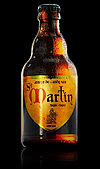 With 9% abv, Abbaye de Saint-Martin is a widely exported tripel Belgian ale.
With 9% abv, Abbaye de Saint-Martin is a widely exported tripel Belgian ale.
Tripel is a term used originally by brewers in the Low Countries to describe a strong pale ale, and became associated with Westmalle Tripel.[44] The style of Westmalle's Tripel and the name was widely copied by the breweries of Belgium,[45] then the term spread to the USA and other countries.[46] Gulden Draak was awarded the best-tasting beer in the world in 1998 by the American Tasting Institute (now ChefsBest).[47] [48]
White or wheat beer
Main article: White beerThis type of beer, commonly called witbier in Dutch, biėre blanche in French and wheat beer in English, originated in the Flemish part of Belgium in the Middle Ages. Traditionally, it is made with a mixture of wheat and barley. Before hops became widely available in Europe, beers were flavoured with a mixture of herbs called gruit. In the later years of the Middle Ages, hops were added to the gruit. That mixture continues today in most Belgian/Dutch white beers.
The production of this type of beer in Belgium had nearly ended by the late 1950s. In the town of Hoegaarden, the last witbier brewery, Tomsin, closed its doors in 1955. However, ten years later, a young farmer, by the name of Pierre Celis, in the same village decided to try reviving the beer. In 1966, Celis began brewing a wit beer in his farm house. Ultimately, his beer took the name of the village and became very successful and famous.
Some notable current examples are Celis White, Blanche de Namur and Watou's Wit. Their alcohol strength is about 5-6 percent ABV, and these beers can be quite refreshing, especially during the warm summer months. The herb mixture traditionally includes coriander and bitter orange peel[49], among other herbs. White beers also have a moderate light grain sweetness from the wheat used. In recent times, brewers have been making fruit flavoured wheat beers.
Winter or Christmas beers
Many breweries produce special beers during December. Most contain more alcohol than the brewery's other types of beer and may also contain spicing. An annual beer festival in Essen, Belgium focuses on this type of beer with over 150 beers available for tasting in 2009.[50]
Glassware
Belgian "special" beers (stronger or bottled beers) are often served in elaborate branded beer glassware.
One of the more common types is the tulip glass. A tulip glass not only helps trap the aroma, but also aids in maintaining large heads, creating a visual and olfactory sensation. The body is bulbous, but the top flares out to form a lip which helps head retention.
A vessel similar to a champagne flute is the preferred serving vessel for Belgian lambics and fruit beers. The narrow shape helps maintain carbonation, while providing a strong aromatic front. Flute glasses display the lively carbonation, sparkling color, and soft lacing of this distinct style.
Chalices and goblets are large, stemmed, bowl-shaped glasses mainly associated with Trappist and Abbey ales. The distinction between goblet and chalice is typically in the glass thickness. Goblets tend to be more delicate and thin, while the chalice is heavy and thick walled. Some chalices are even etched on the bottom to nucleate a stream of bubbles for maintaining a nice head.
In addition to the profusion of glasses provided by brewers, some Belgian beer cafés serve beer in their own "house" glassware. An example is La Lunette in Brussels.[51]
-
Kwak beer with its unusual glass and stand.
-
Hoegaarden Brewery wheat beer in its characteristic hexagonal glass
Distribution
The majority of Belgian beer brands are sold in bottles.[citation needed] Draught beers tend mostly to be pale lagers, wheat beers, regional favourites such as kriek in Brussels or De Koninck in Antwerp; and the occasional one-off.[citation needed] Customers who purchase a bottled beer (often called a "special" beer) can expect the beers to be served ceremoniously, often with a free snack.[citation needed]
These days, Belgian beers are sold in brown- (or sometimes dark green-) tinted glass bottles (to avoid negative effects of light on the beverage) and sealed with a cork, a metal crown cap, or sometimes both. Some beers are bottle conditioned, meaning reseeded with yeast so that an additional fermentation may take place. Different bottle sizes exist: 25 cl, 33 cl, 37.5 cl, 75 cl and multiples of 75. (8, 12, 24 or multiples of 24 fl. oz.) The 37.5 cl size is usually for lambics. Other beers are generally bottled in 25 or 33 cl format (depending on brands). The bigger bottles (75 cl) are sold almost in every food shop but customers do not always have an extensive choice. Bottles larger than 75 cl are named following the terminology used for champagne and are limited in quantity. In Belgian cafés, when someone orders a demi (English: "half"), he receives a 50 cl (half litre) glass (with beer from the tap, or from 2 bottles of 25 cl).[citation needed]
Virtually every Belgian beer has a branded glass imprinted with a logo or name.
Belgium contains thousands of cafés that offer a wide selection of beers, ranging from perhaps 10 (including bottles) in a neighbourhood café, to over 1000 in a specialist beer café. Among the most famous are "Beer Circus," "Chez Moeder Lambic," and "Delirium Café" in Brussels; "de Kulminator" and "Oud Arsenaal" in Antwerp, "De Garre" and "'t Brugs Beertje" in Bruges, "Het Botteltje" in Ostend, "Het Hemelrijk" in Hasselt, "Het Waterhuis aan de Bierkant", "De Dulle Griet" and "Trappistenhuis" in Ghent , "De Blauwe Kater" in Leuven, the Vaudrées in Liège and the "Stillen Genieter" in Mechelen. Although many major brands of beer are available at most supermarkets, off-licences located throughout the country generally offer a far wider selection, albeit at somewhat higher prices.
International distribution
Belgium exports 60% of its beer.[52] Some draught-beer brands produced by InBev - Stella Artois, Hoegaarden and Leffe - are available in several European countries. Aside from these, mostly bottled beer is exported across Europe. Cafés exclusively or primarily offering Belgian beers exist beyond Belgium in Australia, New Zealand, Canada, France, the United Kingdom and the United States, amongst others. Some beer festivals outside Belgium have a Belgian beer bar as an alternative to local products. In North America, a growing number of draught Belgian beer brands have started to become available, often at "Belgian Bars". Such brands include Brasserie Brunehaut, Karmeliet, Kwak, Maredsous, Mont Saint-Aubert, Palm, Rodenbach and St. Feuillien.
Beer festivals
Belgium has a number of beer festivals,[53] including:
- The BAB-bierfestival, held every year in November in Bruges
- The festival held every spring in Leuven (previously in Sint Niklaas and Antwerp) organized by the consumer group Zythos.
- The Belgian Beer Weekend held in Grand Place, Brussels, organized by the Brewer's association.
- Karakterbieren Festival in Poperinge, Belgium's hop-growing capital.
- The Beer Passion weekend held each July in Antwerp, organized by Beer passion magazine,
- The Christmas beer festival Essen
Beer cuisine
A number of traditional Belgian dishes use beer as an ingredient. One is Carbonade (French: the Flemish term is stoverij of "stoofvlees"), a stew of beef cooked in beer, similar to Boeuf bourguignon. The beer used is typically the regional speciality — lambic in Brussels, De Koninck in Antwerp, and so on — so that the taste of the dish varies. Another is rabbit in gueuze. In't Spinnekopke, Brussels, and Den Dyver, Bruges are famed for their beer cookery. In 1998 Anheuser-Busch InBev started a worldwide chain of bars/restaurants, Belgian Beer Cafe, serving typical Belgian dishes combined with Belgian Beer.
The varied nature of Belgian beers makes it possible to match them against each course of a meal, for instance:
- Wheat beer with seafood or fish.
- Blond beers or tripel with chicken or white meat
- Dubbel or other dark beers with dark meat
- Fruit lambics with dessert
Appreciation and organizations
"Beer Passion" is a magazine, which also organizes a beer festival.[54] "Zythos" is the name of the main consumer's organization, successor to the earlier OBP (Objectieve Bierproevers).[55] The Belgian Brewers' Association[56] represents breweries. It organizes beer festivals and an open breweries day. The Knighthood of the Mashstaff honours individuals who have made an outstanding contribution to brewing, and pays tribute to Gambrinus and Saint Arnold.[57]
Beer writers who have written extensively on Belgian beer include Belgians Peter Crombeq and Gert van Lierde, and Britons Michael Jackson and Tim Webb.
References
- ^ "Monks who make world's best beer pray for quiet life - Europe, World - The Independent". London: www.independent.co.uk. 10 August 2005. http://www.independent.co.uk/news/world/europe/monks-who-make-worlds-best-beer-pray-for-quiet-life-502172.html. Retrieved 30 June 2008.
- ^ 500 nieuwe bieren in 4 jaar
- ^ B.E.S (Belgian Label Service)
- ^ The Brewers of Europe - Statistics
- ^ Jef van den Steen, Trappist - Het Bier en de Monniken ISBN 90-5826-214-6, page 33.
- ^ Tomp P Galvin on Orval
- ^ a b Ben McFarland (2009). World's Best Beers: One Thousand Craft Brews from Cask to Glass. Sterling Publishing Company, Inc.. p. 38. ISBN 1402766947. http://books.google.co.uk/books?id=SHh-4M_QxEsC&pg=PA38&dq=Abbey+beers&hl=en&ei=HnkvTaK5Hse7hAeq7ZzpCg&sa=X&oi=book_result&ct=result&resnum=1&ved=0CCYQ6AEwAA#v=onepage&q=Abbey%20beers&f=false. Retrieved 2011-01-13.
- ^ [http://www.beerparadise.be/emc.asp?pageId=294 Beer Paradise on "Recognised Abbey Beer" (Dutch Language)
- ^ "Beer made in Belgium: Abbey beer". beer.made.in. http://beer.made.in/Belgium/abbey.htm. Retrieved 2011-01-13.
- ^ Adam Lindgreen, Joëlle Vanhamme, Michael B. Beverland (2009). Memorable Customer Experiences: A Research Anthology. Gower Publishing, Ltd.. p. 77. ISBN 0566088681. http://books.google.co.uk/books?id=tV4aRexWMygC&pg=PA77&dq=Abbey+beers&hl=en&ei=HnkvTaK5Hse7hAeq7ZzpCg&sa=X&oi=book_result&ct=result&resnum=2&ved=0CCsQ6AEwAQ#v=onepage&q=Abbey%20beers&f=false. Retrieved 2011-01-13.
- ^ a b c "Michael Jackson's Beer Hunter - Belgium's Great Beers". www.beerhunter.com. http://www.beerhunter.com/documents/19133-000222.html. Retrieved 2011-01-13.
- ^ ".:: AFFLIGEM ::.". www.affligembeer.be. http://www.affligembeer.be/. Retrieved 2011-01-13.
- ^ [http://www.brabantsbier.eu/belhist/defabdij.html List of Certified Abbey Beers (Dutch Language)
- ^ http://nl.wikipedia.org/wiki/Brasserie_de_Silly
- ^ http://nl.wikipedia.org/wiki/Brouwerij_Lefebvre
- ^ http://nl.wikipedia.org/wiki/Brouwerij_De_Block
- ^ http://nl.wikipedia.org/wiki/Brouwerij_Van_Steenberge
- ^ http://nl.wikipedia.org/wiki/Brouwerij_Roman
- ^ http://nl.wikipedia.org/wiki/Brouwerij_Van_Steenberge
- ^ http://nl.wikipedia.org/wiki/Brouwerij_De_Smedt
- ^ http://nl.wikipedia.org/wiki/Brasserie_Du_Bocq
- ^ http://nl.wikipedia.org/wiki/Brouwerij_De_Gouden_Boom
- ^ http://nl.wikipedia.org/wiki/Brouwerij_Haacht
- ^ Belgian Beer Shrimper
- ^ a b Tim Webb. Good Beer Guide to Belgium, 6th edition, p 81.
- ^ a b Tim Webb. Good Beer Guide to Belgium, 6th edition, p 84.
- ^ Michael Jackson, Beer Hunter
- ^ Tim Webb. Good Beer Guide to Belgium, 6th edition, p 86.
- ^ The Complete Handbook of Beers and Brewing Brian Glover
- ^ Wall Street Journal. Belgian Brewer Finds Crafty Success
- ^ "Lambicland - The World's Most Complex Beers and Simplest Cafes". booksaboutbeer.com. Archived from the original on 29 March 2008. http://web.archive.org/web/20080329063703/http://www.booksaboutbeer.com/lambicland.html. Retrieved 30 June 2008.
- ^ "Michael Jackson's Beer Hunter - Belgium's Great Beers". www.beerhunter.com. http://www.beerhunter.com/documents/19133-000214.html. Retrieved 30 June 2008.
- ^ Good Beer Guide to Belgium, 6th edition, p70, Tim Webb
- ^ The Complete Handbook of Beers and Brewing p 124, Brian Glover.
- ^ "The great beers of Belgium are not its lagers"--Michael Jackson
- ^ "Michael Jackson's Beer Hunter - Beer Styles: Saison". www.beerhunter.com. http://www.beerhunter.com/styles/saison.html. Retrieved 6 July 2008.
- ^ "Brasserie Dupont". www.belgianexperts.com. http://www.belgianexperts.com/dupont2.php. Retrieved 6 July 2008.
- ^ "MJ FEATURE: Best Beers in the World". www.mensjournal.com. Archived from the original on 7 July 2008. http://web.archive.org/web/20080707034243/http://www.mensjournal.com/feature/0507/bestBeer_world.html. Retrieved 6 July 2008.
- ^ Farmhouse Ales: Culture and Craftsmanship in the European Tradition, page 98, Phil Markowski, Brewers Publications (2004), ISBN 0-937381-84-5
- ^ Tim Webb. Good Beer Guide to Belgium, 6th edition, p 90.
- ^ RateBeer.com - Belgian Strong Ales
- ^ Guardian article retrieved 27 March 2007
- ^ Dutch article retrieved 27 March 2007
- ^ "Michael Jackson's Beer Hunter - Beer Styles: Tripel". www.beerhunter.com. http://www.beerhunter.com/styles/tripel.html. Retrieved 11 July 2009.
- ^ The Great Beers of Belgium, Michael Jackson, MMC, 1997, page 226
- ^ Belgian Ale, Pierre Rajotte, Brewers publications, 1992, pages 31-34
- ^ (Dutch) Van Steenberge Brewery - Gulden Draak
- ^ "Michael Jackson's Beer Hunter - Down on your knees to bless monks' top ale". www.beerhunter.com. http://www.beerhunter.com/documents/19133-000791.html. Retrieved 11 July 2009.
- ^ Hoegaarden - ingredients
- ^ Essen Christmas Beer Festival List retrieved 29 May 2009
- ^ Trip Advisor on La Lunette
- ^ Good Beer Guide to Belgium 6th Edition, Tim Webb
- ^ Top 10 Belgian Beer Festivals
- ^ Beer Passion
- ^ White's Beer Travels on the OBP, DOB and Zythos
- ^ [www.beerparadise.be Beer Paradise]
- ^ The Knighthood of the Mashstaff
- Bibliography
- Good Beer Guide to Belgium, Tim Webb, CAMRA Books, ISBN 1-85249-210-4
- Farmhouse Ales: Culture and Craftsmanship in the Belgian Tradition, Phil Marowski, Brewers Publications (2004), ISBN 0-937381-84-5
- Great Beers of Belgium, Michael Jackson, ISBN 90-5373-012-5
- Lambicland: Lambikland, Tim Webb, Chris Pollard, Joris Pattyn, Cogan and Mater Ltd, ISBN 0-9547789-0-1
External links
- Belgium's Great Beers
- Belgian Beer Map - Distribution of Belgian breweries by provinces
- Brewers in Belgium at the Open Directory Project
Beers of the world Africa 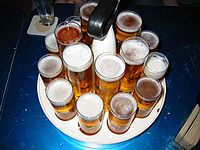
Asia Europe Americas Oceania Beer and breweries by region · List of countries by beer consumption per capita · Alcohol belts of EuropeCategories:- Beer and breweries in Belgium
- Beer culture
Wikimedia Foundation. 2010.

